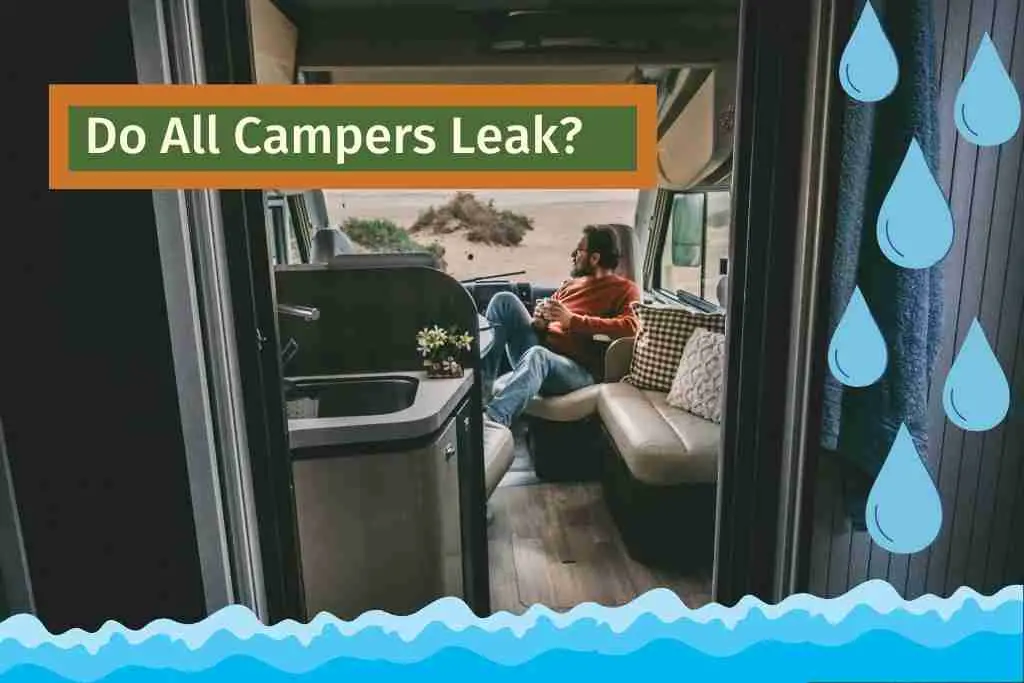If you’ve ever owned an RV or a pull-behind camper, you’ve probably had to deal with one leak or another over the years. For one, many campers have a flat roof, which tends to hold water and, for two, not all campers are created equally.
That doesn’t mean that all campers leak. However, most of them probably will leak at some point in time. This is especially true for campers that have a really flat roof and, as mentioned above, how well the manufacturer designed the roof matters as well.
Then you have to consider campers that have sections that pull out, which are more prone to leaks where they attach and maneuver than campers that are solid from one end to the other. Airstream campers seldom leak at all, thanks to the rounded design which helps with rainwater runoff.
Which Travel Trailers Leak The Least?
While all campers can leak, it doesn’t mean that they will, and much depends on the manufacturer, the quality of the camper, and how well the roof of the camper is designed to drain off. While you shouldn’t go for the most expensive campers just to avoid a leak that is probably going to happen anyway, there are some that are better bets than others.
- Airstreams
- Winnebagos
- Starcraft
- Lance
- Shasta
If you purchase a camper that is used, something that many first-time buyers do, there is an even better chance that you will have to deal with a leak to one degree or another. When you take into consideration the fact that you also have to deal with the expansion and contraction of a roof throughout the seasons, there’s even more potential for a leak.
Just because you purchase one of the above manufacturer’s campers, however, doesn’t mean that you are home free and will never have to deal with leaks either. Ultimately, your best path forward is to practice a little bit of preventative maintenance.
How Do You Find The Source Of A Leak In A Camper?
The most repetitive part of preventative maintenance is how many times per year you should inspect your roof, which should be at least three. You should also recaulk it once per year. There are several parts of the roof and sides in which you should pay particularly close attention.
- Ventilation
- Skylights (if applicable)
- Existing caulking
- Joints where slide-out portions meet the frame
- Windows along the sides
- Ladder mounts
- Roof racks
The problem with caulking anything is that it doesn’t last forever. Over time, caulk dries, cracks, and peels off or fades and has to be replaced on an annual basis. Basically, you want to check over any point of ingress, whether it’s on the side of the camper or on the roof.
The roof isn’t the only place where a camper can spring a leak after all. You should routinely clean your camper as well, which will help you notice any damaged areas or spots where the caulking is cracking or coming up.
Any kind of damage, even if it’s minor, should be taken care of as quickly as possible. You should also check over everything after a bad thunderstorm, especially if your roof was struck by any dead branches or involved in a hail storm.
Do RV Slides Leak?
The most common culprit behind a slide-out leak is the gasket or sealing material. Just like caulking, gaskets, and seals designed to keep your slide-out from leaking eventually fail to keep your slide-out from leaking.
Unfortunately, you can’t caulk a slide-out where the gasket and seal are, so you have to do something else. Like the above examples, you simply have to practice preventative maintenance and keep your eyes on the gaskets and seals.
When they start to crack or wear out, as they inevitably will, you will have to get them replaced. In fact, you really need to keep your eyes on them because failing gaskets and seals are the number one reason behind camper leaks.
Dirt and debris are major culprits. While your slide-out is extended, it is also exposed and any number of things can get in there, especially on a windy day.
- Keep your eyes peeled for dirt and debris along the gasket or seals
- Periodically inspect the corners and attachment joints for water ingress
- Periodically inspect the nuts and blots
- Look for rust or corrosion
- Apply seal conditioner occasionally
Applying a seal conditioner will help extend the lifespan of your gaskets because it helps prevent the inevitable cracking due to time and exposure to both wet and dry weather or changing seasons.
Design Defects In RV Slide Outs
This is a possibility that you shouldn’t overlook. If you notice any kind of water damage along the slide-out area and your camper is practically brand new, the odds are, its a manufacturer defect. Whenever you purchase a camper, you should always go over your warranty thoroughly and see what is covered and what is not.
Camper insurance will only cover damage due to things that are out of your control, like weather and accidents. However, it won’t cover manufacturer defects so the only thing that you can look to for that is the manufacturer’s warranty.
Final Thoughts
All campers are capable of leaking, especially from the roof or slide-outs. However, you can head leaks off by sticking with a solid preventative maintenance plan and doing routine inspections to ensure that everything is in good working order.

